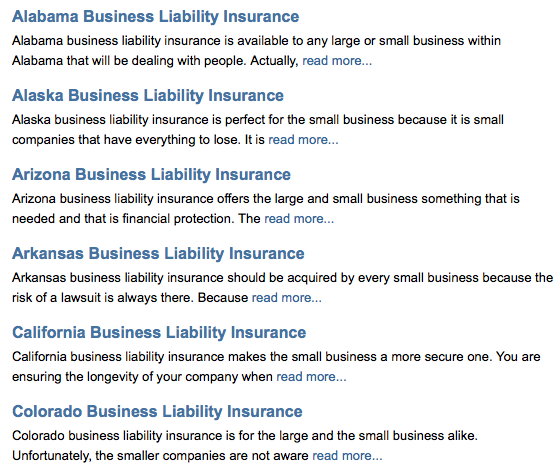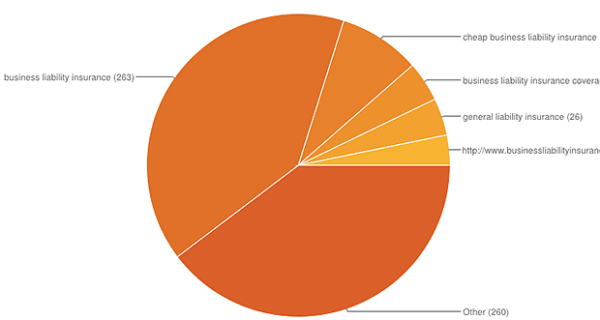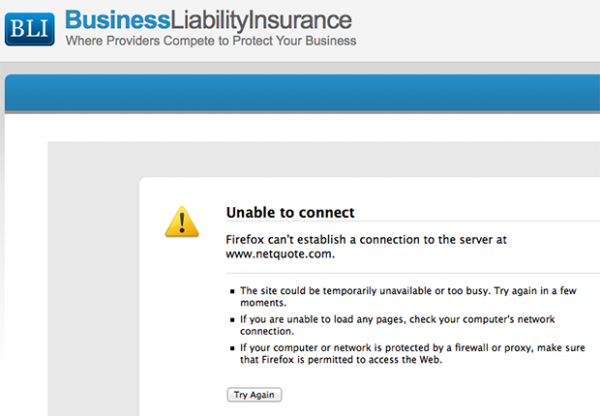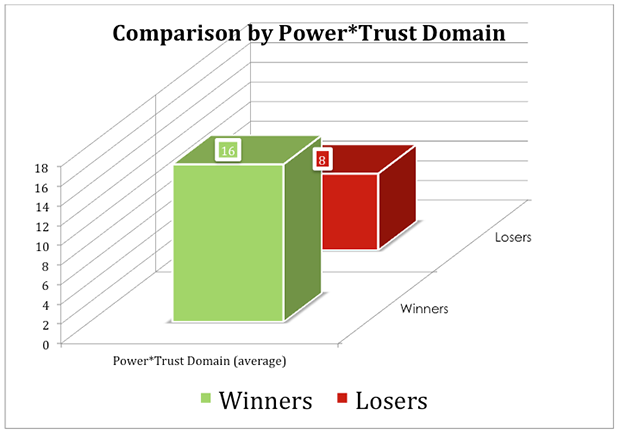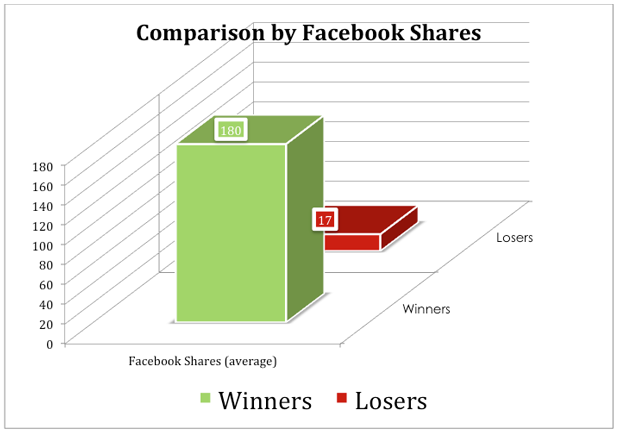Deconstructing The Google EMD Update
Well, it’s official – no more free lunch for EMD, now that the Google EMD Update has launched. It worked well, for a long time. A whole industry of exact match domain tools and brokers came up. Huge premium prices for good names just went through the roof when it was a real “money keyword.” […]

For quite a while, it was possible to rank in the TOP3 with literally no backlinks, compared to non EMDs, often after only a few days in literally every niche you can dream of.
Exact Match Domains (AKA Keyword Domains) are, in general, domain names that exactly match the keyword a website wants to compete for. For example, if a website wants to rank for the term [minor weather report], an exact match domain would be [MinorWeatherReport.com].
For years, it was a free lunch for those in-the-know, and now this loophole is closed, just like other loopholes have been closed years before. But instead of complaining about a free lunch being taken away, SEOs should be thankful for having had it. This cheap way to get traffic, thanks to Google being pretty slow to close the loophole, is now gone.
What The EMD Bonus Included
Two of the first SEO techniques that are taught are on-page keyword optimization and link building. Interestingly, those two things are very closely related to typical sorts of webspam techniques. Perhaps, it is time to focus SEO efforts on abiding by some standards, and make websites for people, not search engines.
EMDs are more than likely being targeted for violating keyword stuffing, other simple webspam techniques, and not building quality sites. The keyword phrase is in the exact match domain name, and this seems like an easy breezy technique. Start with the keyword from the Exact Match Domain and repeat it throughout the page.
The same is true for links. For a long time, the huge EMD bonus was that the website’s name is the money keyword one wants to rank for. It seemed OK to really overdo linking for the money keyword, as we thought Google couldn’t differentiate between that keyword being a brand name or not. Having lots of links and mentions in the body for your brand name (i.e., CEMPER) makes a lot of sense.
However, if you have a website www.BuyCheapSomething.com, it seemed that Google took Buy Cheap Something also as a brand name and ranked you fast for it.
Google Knew It, We Knew It
Don’t think for a minute that this EMD algorithm just came out of the blue. The patent for the EMD algorithm, Systems and methods for detecting commercial queries, was filed way back in September of 2003, and finally approved a year ago on October 25, 2011. Matt Cutts even talked about how they were going to change the EMD game in a video on March 7, 2011. Is Google being transparent by warning us that they are giving too much weight to EMDs?
We went through the weekly winners and losers list from SEOLytics to look for EMDs that had dropped sharply from rather stable rankings from the week before the update. We also did the opposite and found EMDs that actually gained in rankings after the update.
An Actual Example Of An EMD Loser
So, let’s just take a quick look at a few things a top loser did, and see if we can find if the site violated any of the guidelines.
We randomly picked one of the analyzed users and found this website:
www.businessliabilityinsurance.org
At first appearance, this site looks professional and has some reputable insurance company logos. Of course, we see the keyword phrases [business liability insurance] and [liability insurance] throughout the homepage. Perhaps, it isn’t overly done.
However, the FAQs page returns 38 matches for [business liability insurance] and 47 matches for [liability insurance]. Wow! The Guides page returns a total of 100 matches for [business liability insurance].
Are SEOs creating these types of text areas for users or search engines?
If you click thru those articles, you see that they are just spun content throughout the whole site, and are targeting every possible location with the keyword [Business Liability Insurance]. Not surprising that this site tanked — if you just look at the on-page factors of overdoing the commercial keyword.
What About The Link Profile?
Looking at the domain’s Power*Trust, we see a poor value of 6. More on that in a bit.
The anchor texts they used are striking when you look at this. There is not even an approach to mention the URL at substantial amounts (3% only, to be precise). The rest of the keywords are all money keywords in various combinations.
The Trust of those links are less than mediocre. There is only one business.com link at 5 and the remainders mostly below 3.
Other Trust Factors
An interesting Unable to connect error came up when trying to access the Get Quotes page. This error to the netquotes.com site could also be a factor. I would classify this as a mix between a sneaky redirect and cloaking. Perhaps, the netquotes.com site is not a trusted site. While doing our research, it did not appear to load.
Lastly, I really had to laugh at this deceptive maneuver shown below. As users, we value testimonials on websites.
When we see a photo of the person next to the testimonial, the value and perception that this company is trustworthy is even greater.
However, I know these people and they are not who they say they are. LOL! They are stock photos. This is not cool in my book!
Even the testimonials are keyword optimized.
What Is Trust & Why Is It Important?
Following the recent Penguin 3 update, I went back and reread the Another step to reward high-quality sites blog post on Tuesday, April 24, 2012. Again, I am highlighting this, because I believe it is important to read what Google tells us they are doing and not read a bunch of conspiracy and hate comments.
The fact is that Google wants highly-trusted sites in its rankings. And any attempt at manipulating the game will be dealt with. If you don’t believe me that Google is taking webspam seriously, here is a valuable quote from a paper that was written in 2005.
“Please note that according to our definition, all types of actions intended to boost ranking (either relevance, or importance, or both), without improving the true value of a page, are considered spamming.” (Web Spam Taxonomy by Zoltán Gyöngyi & Hector Garcia-Molina)
It is probably worth noting, Zoltán Gyöngyi is a research scientist at Google who went to Stanford and studied with Professor Hector Garcia-Molina, who was the principal investigator for the Stanford Digital Library Project, in which the Google search engine emerged.
We know from our research that by now Google is definitely targeting webspam and low-quality sites with its algorithms. So, what does it take to develop a high-quality site?
Following are some excerpts from our updated EMD Case Study, you can get the full report here.
Domains Compared By Power * Trust™
Since Google is always mentioning the overall quality of a site, I could think of no better metric than the CEMPER Power*Trust metric. (Admittedly, I am slightly biased here.)
Power means the strength based on the number and power of links (better than PageRank™). Trust indicates the implied Trust of the page in Google, according to a system similar to the Trust Rank patent. By combining both metrics, you can easily rate the overall quality of a domain.
The above chart is very clear; the average winner has double the amount of the Power*Trust compared to the losers. This results from a huge number of highly-trusted and very strong backlinks. While most of the losers’ backlinks are potentially low quality, it is pretty clear that the winners have way more links with high Power*Trust.
Our example, businessliabilityinsurance.org, has an even lower Power*Trust value 6 for their domain than the average loser with a Power*Trust value 8.
Domains Compared By Facebook Shares
Social media activity is (and should be) an ever increasing factor in rating the quality of a website. It’s a pretty clear factor to figure out if the audience likes the content and wants to share it with other people.
In general, a very popular website or brand automatically grows in social networks as soon as the reach higher rankings in Google.
This chart shows the huge gap between an average winner’s site with up to 180 shares, whereas the losers have only 17. That might result from the growing priority of a social network, as well as the fact that high quality websites in many verticals simply tend to attract more shares than low quality websites.
Domains Compared By Domain Popularity Growth
The Domain Popularity Growth (i.e., growth of new linking root domains per month) is one of the most important factors for a common natural link profile. A healthy website automatically grows over time because more and more webmasters tend to place a link to a higher quality site.
What we see here is that the winners have constantly more than double the linking domain growth per month than then losers. While the losers have built an average of 1239 new linking domains over the last 2 years (51 per month), the winners have built an average of 3193 new linking domains over the last 2 years (133 per month).
Is Google Really Evil?
Many SEO professionals and webmasters consider Google to be giant, ruthless regime. Many say they don’t follow their own Don’t do evil mantra when it comes to SEOs. Google is the Internet police, etc. etc… Like most regimes, Google constantly tells us that they are trying their best to be transparent. That is what the people want to hear. Google is a transparent corporation that aims to serve its people.
Surprisingly, most governments or corporations are transparent. You just need to read the correct information or listen in a different way. Large, hidden secrets are not implemented without first being written down.
Therefore, it should not be a surprise that the reduce ranking algorithms Google develops are sort of spelled out. Actually, they really are. Mainly, you just need to not violate the quality guidelines and build higher-quality websites.
Organize the world’s information and make it universally accessible and useful. That is Google’s mission.
Stop for a moment, and dream of a day when all search results on the first page are relevant to want you desire. Is it too much to ask for people to read and abide by some laws?
Google EMD Update – A Shock?
So, it comes as a bit of a shock when I hear outrage and panic about Google’s recent Exact-Match Domain algorithm. SEOs are angry, scared, and confused about how this update is harming their sites. Following the Sept. 29th EMD update, it was amusing to read all the caps and cursing at Google in the blogs.
What did people expect? Learn a few basic SEO techniques, abuse the guidelines, and expect not to get caught?
Key Takeaways
- Review Google’s Quality Guidelines and make sure you are not in violation of any obvious tactics. For EMDs, keyword stuffing appears to be very common. Similar rules for normal brand domains apply. Many who got away with webspam techniques in the past, lost their free EMD lunch bonus.
- The overall domain strength is still a very important factor, which means the winners simply got higher quality links and more of them. This makes sense. The typical Quick EMD strategy didn’t need high quality links to rank very high.
- For all you social fans, it does appear that shares could provide a boost in rankings. Further research will need to be done to confirm this. However, I believe that Google takes the social signals and reads this a value of building a high-quality site. See Google bullet point, “Are the topics driven by genuine interest of readers of the site.”
- The domain popularity growth of the winners is so much higher and reflects the overall link and site quality.
- It’s not enough to just build links. More links and better quality lead to a better site, even if it’s an EMD. At least, after the long overdue EMD update.
Finally, Matt Cutts is really sticking to his words to crack down on Web spam in 2012. He closed a lot of loopholes, which surprised me, that were still working during the early part of 2012. I wonder if it’s his secret 30-day challenge to crack down on one old tactic per month?
Personally, I think there’s still a lot more to fix. Based on data we get from our Link Detox technology, which is part of our Link Research Tools software suite (independently reviewed here on SEL), there are still many sites with really bad link profiles and outdated SEO practices that are very easy to detect. I suppose that is also why we should expect these updates to continue on a regular basis.
Again, people, you should thank Matt and Google for letting you get away with EMDs for so long.
Contributing authors are invited to create content for Search Engine Land and are chosen for their expertise and contribution to the search community. Our contributors work under the oversight of the editorial staff and contributions are checked for quality and relevance to our readers. The opinions they express are their own.
Related stories
New on Search Engine Land
